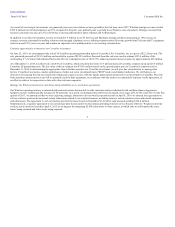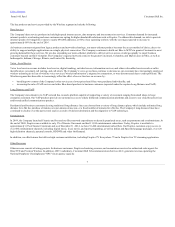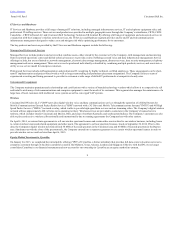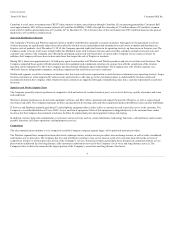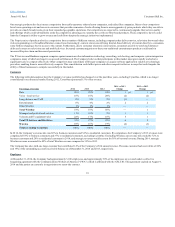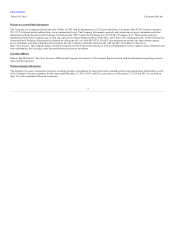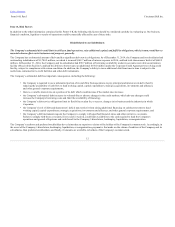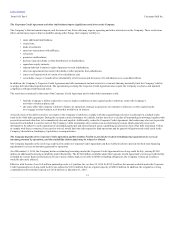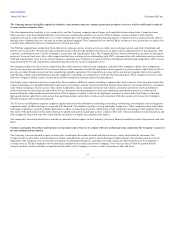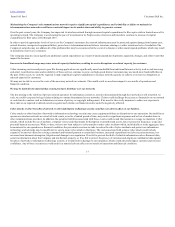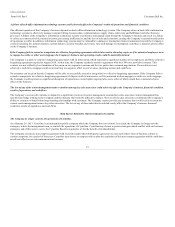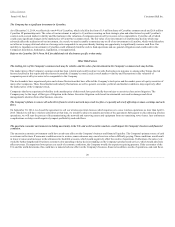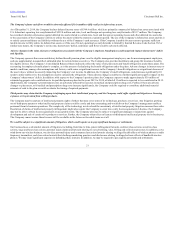Cincinnati Bell 2014 Annual Report Download - page 15
Download and view the complete annual report
Please find page 15 of the 2014 Cincinnati Bell annual report below. You can navigate through the pages in the report by either clicking on the pages listed below, or by using the keyword search tool below to find specific information within the annual report.
Table of Contents
Form 10-K Part I
Cincinnati Bell Inc.
The Company operates in highly competitive industries, and customers may not continue to purchase products or services, which would result in reduced
revenue and loss of market share.
The telecommunications industry is very competitive, and the Company competes against larger, well-capitalized national providers. Competitors may
reduce pricing, create new bundled offerings, or develop new technologies, products, or services. If the Company cannot continue to offer reliable,
competitively priced, value-added services, or if the Company does not keep pace with technological advances, competitive forces could adversely affect it
through a loss of market share or a decrease in revenue and profit margins. The Company has lost, and will likely continue to lose, access lines as a part of its
customer base utilizes the services of competitors or wireless providers.
The Wireline segment faces competition from other local exchange carriers, wireless service providers, inter-exchange carriers, and cable, broadband, and
internet service providers. Wireless providers, particularly those that provide unlimited wireless service plans with no additional fees for long distance, offer
customers a substitution service for the Company’s access lines and long distance lines. The Company believes wireless substitution accounts for the largest
portion of its access line losses. Also, cable competitors that have existing service relationships with CBT’s customers also offer substitution services, such as
VoIP and long distance voice services in the Company's operating areas. Partially as a result of wireless substitution and increased competition, CBT’s access
lines decreased by 9% and long distance subscribers decreased by 8% in 2014 compared to 2013.
Our strategic products also face intense competition from cable operators, other telecom companies, and niche fiber companies. Many of our competitors
have lower operating costs and access to resources that provide economies of scale allowing them to more aggressively price products, which they are able to
provide on a much broader scale given their expanded geographic operations. Our competitors are expected to continuously upgrade their service quality
and offerings, which could substantially erode the competitive advantage we currently have with our fiber-based products. These competitive factors could
limit the Company's ability to grow revenue and cash flows despite the strategic initiatives implemented.
The Fioptics suite of products also face competition from a number of different sources, including companies that deliver movies, television shows and other
video programming over broadband Internet connections. Increasingly, content owners are utilizing Internet-based delivery of content directly to consumers,
some without charging a fee for access to the content. Furthermore, due to consumer electronics innovations, consumers are able to watch such Internet-
delivered content on television sets and mobile devices. Increased customer migration to these non-traditional entertainment products could result in
increased Fioptics churn and decreased penetration. If the Company is unable to effectively implement strategies to attract and retain Fioptics video and
high-speed internet subscribers, retain access lines and long distance subscribers, or replace such customers with other sources of revenue, the Company's
Wireline business will be adversely affected.
The IT Services and Hardware segment competes against numerous other information technology consulting, web-hosting, and computer system integration
companies, many of which are large in scope and well-financed. This market is rapidly evolving and highly competitive. Other competitors may consolidate
with larger companies or acquire software application vendors or technology providers, which may provide competitive advantages. The Company believes
that many of the participants in this market must grow rapidly and achieve significant scale to compete effectively. This consolidation could affect prices and
other competitive factors in ways that could impede our ability to compete successfully in the market.
The competitive forces described above could have a material adverse impact on the Company’s business, financial condition, results of operations, and cash
flows.
Failure to anticipate the need for and introduce new products and services or to compete with new technologies may compromise the Company’s success in
the telecommunications industry.
The Company’s success depends, in part, on being able to anticipate the needs of current and future business, carrier, and residential customers. The
Company seeks to meet these needs through new product introductions, service quality, and technological improvements. New products and services are
important to the Company’s success because its industry is technologically driven, such that new technologies can offer alternatives to the Company’s
existing services. The development of new technologies and products could accelerate the Company’s loss of access lines or limit the growth from its
strategic products, which would have a material adverse effect on the Company’s revenue, results of operations, and cash flows.
15


